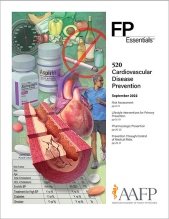
This clinical content conforms to AAFP criteria for CME.
Diabetes, hypertension, tobacco use, and obesity each substantially increases the risk of cardiovascular disease (CVD) and must be controlled as part of CVD prevention. Among patients with diabetes, the reduction of CVD risk from lower A1c goals must be balanced against the risks of hypoglycemia. The American Diabetes Association (ADA) recommends an A1c goal for adults of less than 7% if hypoglycemia can be avoided. A less stringent goal of less than 8% is appropriate in patients with limited life expectancy. A blood pressure (BP) goal of less than 140/90 mm Hg is prudent for all adults younger than 60 years. A goal of less than 140/90 mm Hg also is advised for initiating or intensifying pharmacotherapy in adults 60 years and older with a history of stroke or who are at high cardiovascular risk. BP targets should be individualized to balance the known benefits of lowering BP to 120/80 mm Hg with the risks of morbidity because of hypotension and adverse effects. Varenicline is the most effective drug for smoking cessation, and abstinence rates are increased by combining it with nicotine replacement therapy. Bariatric surgery is the most effective management for long-term weight loss and reduction of obesity-related comorbidities. Social drivers of health are the primary cause of CVD outcomes differences among races and ethnicities.
Case 4. LS is a 60-year-old woman who comes to your office with a 10-year history of type 2 diabetes and a 40-pack-year smoking history. She asks what she can do lose weight and stop smoking. Her blood pressure is 154/92 mm Hg and body mass index (BMI) is 38 kg/m2. Her fasting glucose level is 146 mg/dL and A1c level is 7.6%. She currently takes hydrochlorothiazide 12.5 mg/day, metformin 1,000 mg 2 times/day, and simvastatin 40 mg/day.
Subscribe
From $350- Immediate, unlimited access to FP Essentials content
- 60 CME credits/year
- AAFP app access
- Print delivery available
Edition Access
$44- Immediate, unlimited access to this edition's content
- 5 CME credits
- AAFP app access
- Print delivery available
